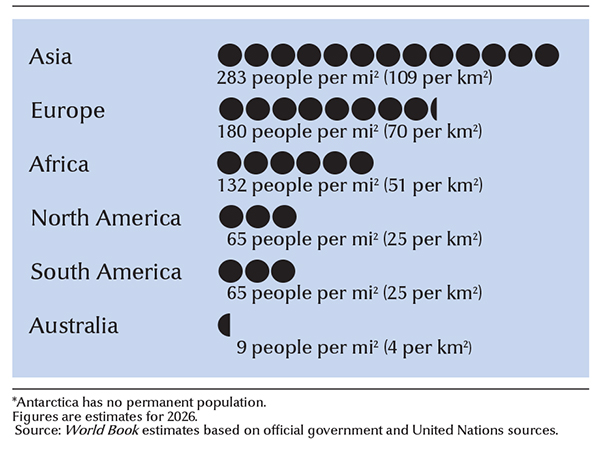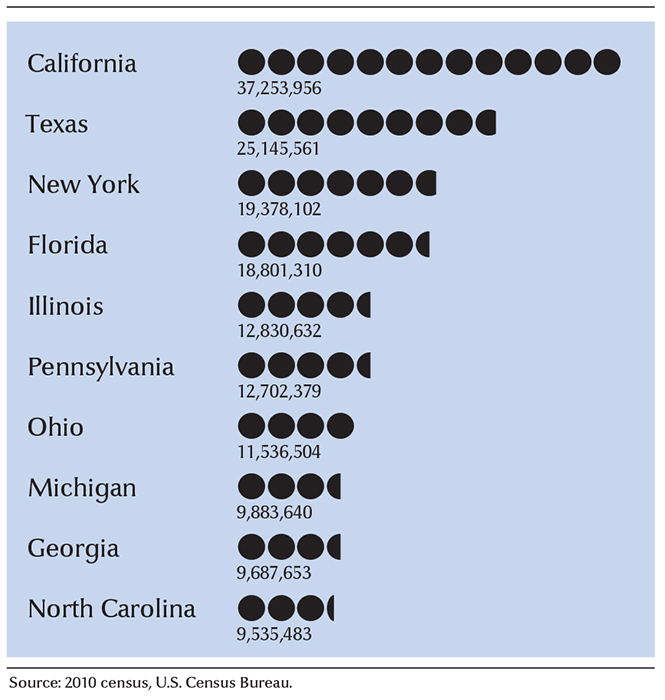Population of a country or other area is the total number of people who live in it. Populations change as a result of migration and a process called natural increase. Natural increase is the difference between births and deaths. Most countries have more births than deaths, and so their population increases, unless a net loss results from migration.
World population
The world’s population rose to about 7.8 billion by 2020. The number of people is increasing at an annual rate of about 1.07 percent. Scholars estimate that the world’s population totaled about 550 million in 1650. By 1850, the population had doubled to about 1,100 million. Since 1850, the world’s population has increased about sevenfold. See World (Population).
European populations in Europe and overseas increased rapidly in the 1700’s as death rates dropped. But declines in birth rates reduced population growth and eventually led to a decrease in some countries. In the early 2020’s, European countries with decreasing populations included Bulgaria, Hungary, Latvia, Romania, and Ukraine.
In most of Asia, Africa, and Latin America, death rates declined rapidly during the mid-1900’s. Longer life spans were brought about by the reduction of famines and epidemics, by improved water supplies and sewage disposal, and by better medical care.
The populations of continents show the effects of differing rates of both migration and natural increase. The past 300 years have been a period of several great migrations, including that of Europeans to the Americas and some Pacific areas.

Asia is the most populous continent, with about three-fifths of the world’s population. The two countries with the largest populations are in Asia. They are India, which has about 1.4 billion people, and China, which also has about 1.4 billion. The two next largest countries are the United States, with about 334 million people, and Indonesia, with about 274 million people.
Urban and rural population.
Migration from rural areas to cities grew with industrialization in Western countries and Japan. Today, it is occurring in most countries, even in those that remain predominantly agricultural. In 1800, only about 5 percent of the people of the United States lived in urban areas. Today, about 85 percent live in urban areas. In 1800, about 20 percent of the population of England lived in cities. Today, about 95 percent live in cities.
Census.
Most governments conduct censuses (regular counts of the population) to learn the numbers, the places of residence, and the characteristics of their peoples. Most countries in the world have taken at least one census in the last 10 years. The United States government has taken a census of the American population every 10 years since 1790. India and the United Kingdom also take their census every 10 years. Australia, Canada, Japan, and New Zealand each conduct a census every 5 years.
Governments also collect information on birth and death rates, called vital statistics. The study of the size, distribution, and characteristics of populations, and of changes in population, is called demography. The United Nations helps countries improve their demographic information.
Age.
A population growing rapidly because of a high birth rate usually has a high proportion of children. A slowly growing population usually has a low proportion of children. Current estimates for the population of the world indicate that about 25 percent of the people are below 15 years of age. About 66 percent of the people are between the ages of 15 and 64, and about 9 percent are over 64 years of age. In the United States, 19 percent of the people are less than 15 years old, 66 percent are between 15 and 64, and 15 percent are over 64. In Ethiopia, Nigeria, Tanzania, and other countries with high birth rates, about 40 percent of the people are below 15 years of age.
Statistics on the proportions of various age groups help society prepare for more schoolchildren, workers, or aged people. The dependency ratio is a comparison of the number of children and elderly people with the number of people in the main working ages. This ratio is high if a large proportion of the population are dependents. Nations with a rapidly growing population have a high dependency ratio. The support of dependents places a burden on the workers of such countries, and many children and older adults may try to find work.
United States population
In the United States, the first federal census in 1790 determined that about 4 million people lived in the country. By 2020, the U.S. population had increased to about 330 million. The rate of growth was highest from 1790 to 1860, when it was about 3.5 percent a year. By the 1930’s, the rate had decreased to 0.7 percent a year.
Another period of rapid growth, called the baby boom, occurred from 1946 to 1964. The growth rate reached a high of 1.8 percent during this period. Since 1964, the rate has again slowed. Today, the growth rate is about 0.6 percent a year. About 40 percent of this growth is due to immigration rather than natural increase.

The growth of the various regions of the United States is influenced greatly by migrations within the country. Since 1970, the West has grown most rapidly and the Northeast region least rapidly. Mild climates and economic expansion attracted many people to the South and West.
Men outnumbered women throughout most of the history of the United States because men were more numerous than women among immigrants. But women have a higher life expectancy than men. Thus, as immigration declined, the proportion of women increased. Since 1950, there have been more women than men in the United States. Women will likely remain in the majority despite recent high levels of immigration because today’s immigrants include many family groups and single women.
The U.S. population is made up of people of many nationalities and ethnic groups. For statistical purposes, the main groups are: (1) white people who are not Hispanic Americans (about 58 percent of the people); (2) Hispanic Americans of any race (about 20 percent); (3) Black people who are not of Hispanic descent (about 12 percent); (4) Asian people and Pacific Islander people (about 6 percent); (5) Aleut and Inuit peoples, and Native Americans who are not of Hispanic descent (less than 1 percent); and (6) people of two or more ethnic groups (about 4 percent).
The future growth of the population depends on many factors, and it is not possible to know exactly what will happen. The U.S. Census Bureau expects that the rate of population growth in the United States will remain low. Nevertheless, the total population reached 300 million in 2006. It could pass 400 million by the year 2050.
The population explosion
The world’s population passed 5 billion in 1987, 6 billion in 2000 , and 7 billion in 2011. The population is increasing by approximately 1.07 percent each year. If this rate of growth continues, the population will reach 11 billion around the year 2050. This rapid increase has been called the population explosion.
Causes.
For thousands of years, birth rates were high. However, the population increased slowly and sometimes declined because death rates also were high. Then, during the 1700’s and 1800’s, advances in agriculture, communication, and transportation improved living conditions in parts of the world and reduced the occurrence of many diseases. As a result, the death rate began to drop, and the population grew rapidly.
In the industrial countries of Europe and North America, many people flocked to the cities and took jobs in factories. In cities and in many rural areas, it was difficult to support a large family. People began to see reasons for having smaller families. As a result, birth rates in these countries began to fall. In the agricultural countries of Africa, Asia, and Latin America, declines in death rates did not occur until the mid-1900’s. Then death rates plunged quickly without corresponding declines in birth rates. As a result, the population of low-income nations and of the world increased rapidly.
Effects.
Many scientists, economists, and other experts fear that food production cannot keep pace with the population for long. They believe the world already is or will soon become overpopulated–that is, it will have more people than it can support at an acceptable standard of living. This theory was put forth by the British economist Thomas Robert Malthus in the late 1700’s. Malthus stated that population tends to increase beyond the limit of Earth’s ability to support it. He predicted that famine, war, and other disasters would become common unless people cut the growth rate.
Many people dispute Malthus’s views. They point out that since Malthus made his gloomy forecast, world population has grown by more than 6 billion. More people are living longer and healthier lives than ever before. Many experts believe it is technologically possible to increase world food production by more than 1.7 percent yearly and thus to keep ahead of population growth. During the 1960’s, for example, improved farming methods and new high-yield crop varieties helped many poor countries increase their food production by about 25 percent. This effort proved so successful that it has been called the Green Revolution. Some people believe that the problem is not too many people, as Malthus claimed there were, but too much inequality. They think that starvation and poverty could be overcome with a more equal distribution of existing resources. Many people have more than enough to eat, but many others go hungry.
Population control.
Many experts have expressed concern that people in rich and poor countries alike consume too much, destroy forests and soil, pollute the environment, and damage prospects for human survival on Earth. They believe disastrous shortages of food and other necessities can be avoided only by halting population growth. They urge that the birth rate be reduced to replacement level, an average of about 2.1 children per woman, so that only enough people are born to replace those who die. The resulting condition is called zero population growth or ZPG. In the United States and Europe, fertility is below replacement level. But in many of the world’s poorer countries, women have an average of as many as 5 or 6 children.
The governments of many countries have promoted birth control programs in efforts to reduce the birth rate. China, for example, from 1979 to 2015 promoted a social policy that led millions of couples to have only one child. In many other countries, birth rates have declined more slowly and are still far above replacement level.
The decisions that women and men make about having children are influenced by many other factors besides government policies. These factors include their social and economic circumstances, their religion, their education, their need to have someone care for them in their old age, their feelings about the future, and their access to information and medical care. As a result, future social and economic changes will have important effects on birth rates and population growth.
